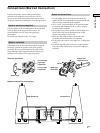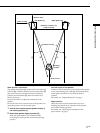
4
GB
SS-M9ED Features
In the design of the SS-M9ED, we focused on the
following three key areas of performance:
• Enhancement of resolution and detail
The SS-M9ED provides the very high-resolution and
detailed sound reproduction demanded of new audio
sources such as Direct Stream Digital (DSD) and Super
Audio CD (SACD).
• Increase in dynamic range
The SS-M9ED boasts a wide dynamic range and very
low distortion, making it capable of reproducing the
high-quality sound of DSD and SACD.
• Expanded bandwidth
The SS-M9ED provides the wide bandwidth (up to
about 100 kHz) required for the reproduction of the
entire frequency range of DSD and SACD.
Because of the above design considerations, the SS-M9ED
has been provided with the following features:
Network Circuitry Design
The SS-M9ED’s network circuitry doesn’t only divide the
signal bandwidth into separate ranges at each speaker, it
also controls the phase and distortion characteristics of the
signal. On top of this, it provides a naturally and
musically integrated sound from each speaker.
Of course, the more parts added to a network circuit, the
more degradation occurs in the audio signal. For this
reason, SS-M9ED’s network circuitry was designed to be
as simple as possible. The result is a natural-sounding
output with smoother isolation characteristics, higher
transparency, and superb resolution.
Furthermore, the network was laid out in such a way that
to provide mutual separation among all the components,
thereby minimizing mutual interference and vibration.
Internal wiring material was also selected for stability in
impedance characteristics and resistance to the effects of
vibrations. The final selection of parts, all of the highest
electrical and mechanical quality, was made after rigorous
screening in the listening room.
Speaker Cabinet Design
The SS-M9ED cabinet serves the following three
functions:
• Securing and positioning of the speaker units.
• Processing of sound waves emanating from the rear of
the speaker units (i.e., the isolation of rear sound waves
from the front sound waves).
• Enhancement of low-frequency characteristics.
The ideal speaker cabinet for the SS-M9ED was assumed
to be an invisible one. In other words, the speaker cabinet
should “disappear” as soon as the music began, making it
seem to the listener that only the music existed.
To achieve this, we incorporated the following
considerations in the SS-M9ED’s speaker cabinet:
— Time alignment-geared design
Through precise measurements, we located the
sound source of each speaker unit and minimized
the phase gap between each speaker unit.
— Elimination of standing waves and early reflections
The lack of parallel surfaces and the use of round
baffles served to prevent the degradation of sound
quality by standing waves and early reflections.
— High rigidity
Baffles made of a unique 50 mm thick composite
anti-vibration structure were incorporated, while
other parts of the cabinet were constructed from
Medium Density Fiberboard (MDF) substrate
approximately 25 mm in thickness.
— Three-point support using spikes
The spikes supplied with the speaker provide a
stable and secure support for the speaker. They also
limit floor contact to small points, thus reducing the
potential influence of various types of flooring
materials (carpet, etc.).
Speaker Unit Design
The basic sound quality of a speaker depends on the
performance of the speaker units. A speaker unit must
convert input audio signals into sound energy without
loss or exaggeration. A high-performance speaker unit
should thus have a flat frequency response, smooth phase
response, wide directivity, and low distortion. The
SS-M9ED was developed to achieve maximum
performance within the applicable frequency range in all
of these aspects.
For the SS-M9ED, sound quality was the foremost
criterion in the selection of speaker units. Even when new
materials or technologies were incorporated in a speaker
unit, verification of a link between those materials and
technologies with improved sound quality was required
before the speaker unit would be chosen.
European speaker unit manufacturers were commissioned
to design the three types of speaker units used in the
SS-M9ED (woofer, mid-range, tweeter) according to our
specifications. However, because of the extremely strict
specifications of the super-tweeter, the development of
this unit was carried out in Sony’s own laboratories.


















